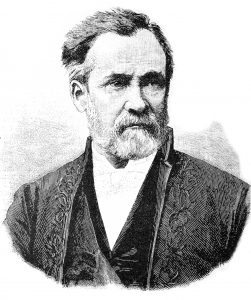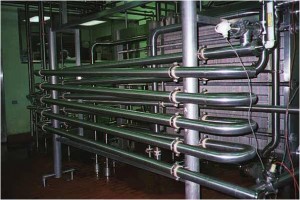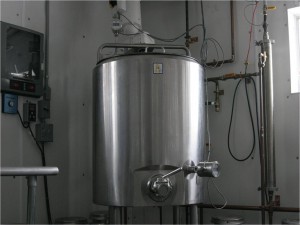 As mass production and distribution of milk took off back in the 1800s, we started to realize that people were becoming sick from milkborne outbreaks (crazy stuff like tuberculosis, yikes!). In 1864, Louis Pasteur developed a method of killing harmful bacteria and extending the shelf life of commonly consumed beverages. While his original intent for pasteurization was to be used for more social cocktails like beer and wine, it was discovered as being equally as helpful with the outbreaks associated with milk. This process was named “pasteurization” after its brilliant designer. Pasteurization involves heating liquids at high temperatures for short amounts of time. Pasteurization kills harmful microbes in milk without affecting the taste or nutritional value (sterilization= all bacteria are destroyed).
As mass production and distribution of milk took off back in the 1800s, we started to realize that people were becoming sick from milkborne outbreaks (crazy stuff like tuberculosis, yikes!). In 1864, Louis Pasteur developed a method of killing harmful bacteria and extending the shelf life of commonly consumed beverages. While his original intent for pasteurization was to be used for more social cocktails like beer and wine, it was discovered as being equally as helpful with the outbreaks associated with milk. This process was named “pasteurization” after its brilliant designer. Pasteurization involves heating liquids at high temperatures for short amounts of time. Pasteurization kills harmful microbes in milk without affecting the taste or nutritional value (sterilization= all bacteria are destroyed).
Excerpt taken from the Conference for Food Protection addressing the Senate:
“Each year, foodborne diseases sicken an estimated 48 million Americans, killing 3,000 of them. Many of these deaths are preventable. Relying on sound science and proven safety interventions- such as pasteurization- is one way to prevent illness. Prior to pasteurization, milk was a common source of the bacteria that cause tuberculosis, Q fever, diphtheria, severe streptococcal infections, typhoid fever, and other foodborne illnesses. The incidence of disease outbreaks associated with milk has fallen dramatically since pasteurization of milk became widespread. The number of milk-related outbreaks has dropped from nearly 25 percent of all disease outbreaks due to contaminated food and water in 1938 to less than 1 percent of reported outbreaks today. Importantly, of that 1 percent, an overwhelming majority- 70 percent- of outbreaks are linked to raw milk.”

- Cow feces coming into contact with the milk (it’s all pretty close down there!)
- Infection of the cow’s udder (A.K.A. mastitis)
- Bacteria that live on the cows skin- don’t worry Bessie, we all have it
- Farming environment (dirt, feed, equipment)
- Insects, rodents and other disease carrying animals on the farm
- Humans (contamination from clothing, improper handwashing, etc.)
- Drugs used to treat sick cows
*All of these apply regardless of the milking animal. Goat milk has the same potential for contamination as cow’s milk!
So to reduce the risk of contaminants in your cup, we pasteurize. There are two very common ways to pasteurize milk: 1) batch (commonly known as ‘vat’) pasteurization and 2) continuous flow pasteurization. Batch pasteurization involves heating every particle of milk in a large tank or vat to a minimum of 145° F for a minimum of 30 minutes.
Examples of continuous flow pasteurization are:
- High-Temperature, Short-Time (HSTS) pasteurization: requires that the milk be held at a minimum of 161°F for 15 seconds.
- Ultra-High Temperature (UHT) pasteurization: uses much higher temperatures varying from 275-302°F for 4-15 seconds.
Both HSTS and UHT use similar methods of forcing raw milk through metal pipes and thin metal plates. The metal is heated on the outside, which heats the flowing milk to the appropriate temperature. This system allows for the appropriate time for heat control before it pushes the milk to the rapid cooling area of the pasteurizer. The expedited cooling of the milk to a temperature below 41°F helps to prevent further bacterial growth (the stuff responsible for spoilage) that may still be present and can thrive at middle temperatures (this is why you must keep your milk in the refrigerator!). The cold milk is then bottled or stored in a sealed container to ensure no contaminates enter after the pasteurization process. To become an “expert” on the process of pasteurization, take a look at the FDA’s mini-online course.
The pasteurization of milk has saved countless lives and even more cartons of milk! Bacteria not only causes milk to sour but certain types of bacteria also cause illness, so minimizing bacteria in milk is important. Drinking ONLY pasteurized milk from an approved source is the only way of ensuring the safety of your milk and protecting you and your family.
 |
 |
